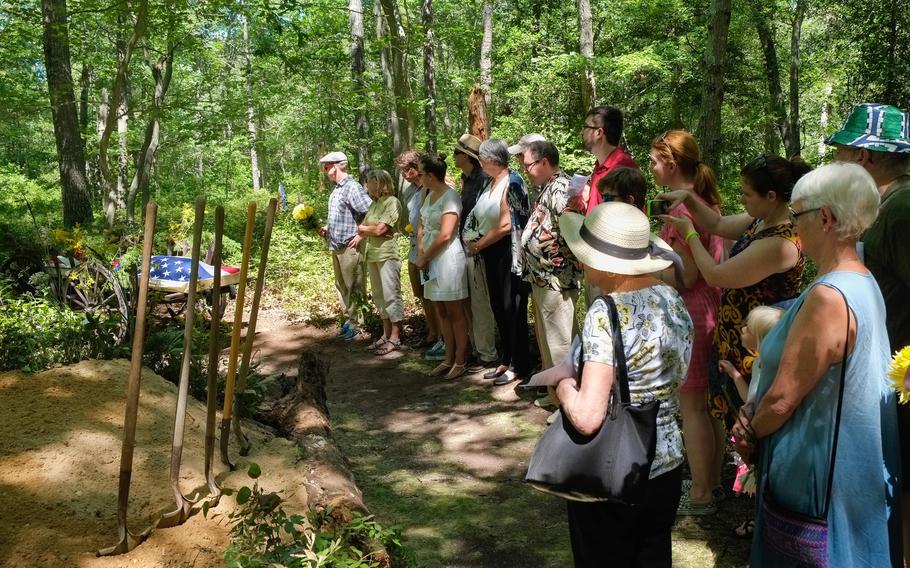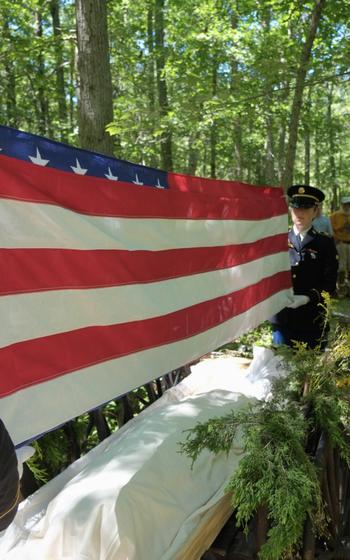
Mourners stand before the gravesite of Edward Hoffner, a World War II veteran who died in 2016. His daughter, Ann Hoffner, chose a green burial for her father that used only biodegradable materials and no embalming chemicals, grave liner or vault. Hoffner was buried at Steelmantown Cemetery, a natural burial preserve in New Jersey. (Courtesy of Ann Hoffner)
WASHINGTON — Christopher, a Marine Corps veteran who survived a truck explosion while serving in Afghanistan, said the near-death experience caused him to consider his own mortality and how he wants his burial to be handled.
The 35-year-old Colorado resident, who declined to provide his last name, said he has done advance planning and conveyed his desire to have a natural burial, also known as a green burial, that does not burden loved ones with thousands of dollars in funeral bills.
In contrast to the pomp and circumstance of traditional military funerals, a growing number of veterans say they prefer a simple, low-cost burial that forgoes the luxury of lined caskets and marble urns for a natural interment with minimal impact to the environment, according to a recent survey of veterans by the Department of Veterans Affairs.
Based on survey feedback, the VA recently opened green burial sections at three national cemeteries that limit markers and landscaping, forgo chemicals and embalming fluids, and use caskets, shrouds and urns from natural materials that degrade over time.
The green burials are offered at Pikes Peak National Cemetery in Colorado Springs, Colo.; the National Memorial Cemetery of Arizona in Phoenix; and Florida National Cemetery in Bushnell, which is north of Tampa.
The VA survey showed respondents ages 40 and under had the greatest interest in natural burials and overwhelmingly supported green alternatives.
“Just put me in a pine box where my body can decompose and return to nature,” said Christopher, a former sergeant who served between 2007 and 2016 in Iraq and Afghanistan.
Interest by veterans and their families in green burials parallels a national trend among Americans seeking alternatives to formal funerals with costly grave sites, underground vaults and a standardized burial process that does not allow for individual expression, according to Ann Hoffner, who publishes “Green Burial Naturally,” a state-by-state guide to natural burials.
The number of cemeteries offering green burials has grown from 42 in 2016 to more than 300 in 2024, Hoffner said.
Hoffner first learned about green burials through her own experience seeking an alternative to a conventional funeral for her 94-year-old father, a World War II veteran who died in 2016.
Edward A. Hoffner was an Army lieutenant who participated in the liberation of France, his daughter said.
Hoffner published an essay about her father’s natural burial at a wooded sanctuary, comparing it to a cousin’s traditional funeral “in a painted casket in a concrete vault under an Astroturf temporary covering” at a memorial park.
An American flag was draped over her father’s body, which was wrapped in a shroud of natural material. Mourners placed his body in a wooden wagon that was wheeled to his grave at Steelmantown Cemetery, a woodland burial preserve in New Jersey.
An honor guard played Taps and fired a three-volley salute as a final farewell after the body was lowered into the ground.

An honor guard folded the American flag at the 2016 funeral of Edward Hoffner, a World War II veteran buried at a woodland preserve in New Jersey dedicated as a natural burial site. Hoffner’s body was wrapped in a shroud of natural material before being lowered into the ground. (Courtesy of Ann Hoffner)
“The wild blueberries had been pulled back to admit his body and would be replanted,” Ann Hoffner wrote. “It was an extraordinary realization that he had joined an ecosystem. It would recycle the nutrients in his flesh and bones and weave them into life.”
While the Hoffner family holds a deed to his burial plot, there are no grave markers or head stones.
The simplicity of green burials also makes them less costly for the survivors. They typically cost about $6,000, but prices vary by location and the services selected, according to the Green Burial Council.
Conventional funerals can run up to $15,000 — with fees for viewing, burial, refrigeration, transport, casket purchase and embalming. Standard caskets and urns alone can cost thousands of dollars.
When a veteran dies, the Department of Veterans Affairs provides a burial allowance to offset the costs of a funeral, with the family responsible for the difference.
For service-connected deaths, VA pays up to $2,000 for burial expenses of former service members who died after Sept. 11, 2001. It provides up to $1,500 for deaths prior to that date.
If the veteran is buried in a VA national cemetery, some or all of the cost of transporting the deceased may be reimbursed.
For non-service-connected deaths, VA will pay up to $978 toward burial and funeral expenses with a $978 plot-interment allowance, if the veteran is not buried in a national cemetery.
The National Cemetery Administration will accept cremated and intact remains for green burials at the three cemeteries participating in the pilot program.
According to the National Funeral Directors Association, nearly 70% of Americans surveyed expressed interest in learning about green burials as a funeral option because of the lower costs and benefits for the environment.
Congress in 2022 authorized the VA to establish green burial sections in national cemeteries.
Under the National Cemeteries Preservation and Protection Act, a veteran’s remains interred in a green burial section must be prepared without chemicals and using caskets and urns that will naturally degrade in the environment.
The idea behind green burials is to allow the body to recycle in the natural environment with little disturbance to the surroundings, according to the Green Burial Council.
“When it comes to green burials, I like to say there are many shades of green. For some families, green burial means no chemical preservation of the body, a casket made of natural material, and no vault or grave liner if the cemetery allows,” said Lily Buerkle, director of funerals for the historic Congressional Cemetery in Washington, where 1,700 veterans are interred.
The private, nonprofit cemetery is unique among burial grounds in Washington for providing both natural burials and conventional funerals.
.jpg/alternates/LANDSCAPE_910/20241227_Green_Burial_0050%202.jpg)
The Circle of Life as seen Thursday, Dec. 26, 2024, is a living memorial to those who had green burials at Congressional Cemetery in Washington. Congressional Cemetery is the only site in Washington, D.C., that offers green burials. (Eric Kayne/Stars and Stripes)
At green burials, families “tend to want to be active participants in their loved one’s funerals,” Buerkle said. “They want to put their grief to action — whether that is helping to bathe and shroud their person, or hand-shovel earth at the cemetery, or lead their own heartfelt ceremonies without clergy. They want to be a vital part of it,” she said.
Buerkle, who is a licensed mortician in D.C., Maryland and Virginia, said she appreciates that the National Cemetery Association is giving veterans and their families the option of green burials at some of its cemeteries.
Natural burials are unavailable at most U.S. cemeteries, despite their growth in popularity over the last decade, she said.
“This is a giant leap forward to allow veterans’ families access to greener burial options,” Buerkle said. “I love knowing that our veterans are beginning to have these choices.”
Jane Pennington, 98, of Maryland said she sought a more eco-friendly alternative to cremation, which dumps toxins into the air, when she began making funeral arrangements for her late husband, an Army and Air Force veteran who served in 1945 and 1946.
“Crematoriums are usually located in disadvantaged areas in the city, so my husband and I had decided while he was alive that we would start looking for an alternative,” Pennington recalled.
Kenneth Pennington, 96, died in 2023. The former Air Force corporal had served in an Army specialized training corps while studying to be an engineer in college. He joined the Air Force after graduation and was assigned to a military installation in Dayton, Ohio.
After her husband’s death, Jane Pennington said she found Serenity Ridge, a new cemetery in Maryland where burial vaults and embalming chemicals are not permitted. A trail network leads to wooded burial sites.
“By offering a recreational green space with walking trails, families are invited to embrace the space itself, and the cemetery enjoys a dual purpose,” said Ed Bixby, founder of the Global Green Burial Alliance, which promotes eco-friendly funeral options.
There are more than 18 million U.S. military veterans. Many of the veterans are at an advanced age, which means a higher number of deaths are expected each year.
Christopher, the Marine Corps veteran in Colorado, said he has thought about that statistic when considering a natural burial for his funeral someday.
“America basically has been at war every 10 years. In my view, we don’t have the space it will take at veterans’ cemeteries to put people in $8,000 caskets and concrete vaults in the ground,” he said. “The amount of land that these cemeteries take up is ridiculous.
“I see natural burials as another way for veterans like myself to give back to our country and community. Guys I served with did not enlist for the recognition,” he said. “We were just doing our job.”